
Home - Search - Browse - Alphabetic Index: 0- 1- 2- 3- 4- 5- 6- 7- 8- 9
A- B- C- D- E- F- G- H- I- J- K- L- M- N- O- P- Q- R- S- T- U- V- W- X- Y- Z
Nuclear/LH2
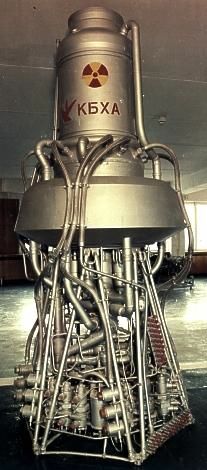
RD-0410 NTP Engine
RD-0410 Nuclear Thermal Engine
Credit: © Dietrich Haeseler |
Nuclear/LH2 propellant. Nuclear thermal engines use the heat of a nuclear reactor to heat a propellant. The ideal working fluid for space applications is the liquid form of the lightest element, hydrogen. Nuclear engines would have twice the performance of conventional chemical rocket engines. Although successfully ground-tested in both Russia and America, they have never been flown due primarily to environmental and safety concerns. Liquid hydrogen's drawbacks, especially for long-duration missions to Mars, for which nuclear thermal engines were mainly considered: it was highly cryogenic, and it had a very low density, making for large tanks and the need for solar shielding and reliquefaction systems to ensure the hydrogen would stay liquid during the long trip to Mars and back. There were also many operational issues regarding getting the engine into operation and shutting it down - it was a long process. The Russians solved some of these issues by using the engine as a power source during the cruise to Mars and back.
Fuel Density: 0.071 g/cc. Fuel Freezing Point: -259 deg C. Fuel Boiling Point: -253 deg C.
Subtopics
 | EMPIRE Aeronutronic American manned Mars flyby. Study 1962. Aeronutronic's Mars flyby spacecraft design of 1962 had a total mass of 170 metric tons and would be launched into low earth orbit with a single launch of a Nova booster. |
 | EMPIRE General Dynamics American manned Mars flyby. Study 1962. General Dynamics' manned Mars orbiter spacecraft design of 1962 had a total mass of 900 metric tons and would be launched into low earth orbit with a two launches of a Nova booster or eight launches of a Saturn V. |
 | EMPIRE Lockheed American manned Mars flyby. Study 1962. Lockheed's manned Mars flyby spacecraft design of 1962 had a total mass of 100 metric tons. |
 | FLEM American manned Mars expedition. Study 1966. |
| Helios A-2 Nuclear/LH2 propellant rocket stage. Nuclear second stage. |
| Helios B-2 Nuclear/LH2 propellant rocket stage. Nuclear second stage. |
| Helios C-2 Nuclear/LH2 propellant rocket stage. Nuclear second stage. |
 | IMIS 1968 American manned Mars expedition. Study 1968. In January 1968 Boeing issued a report that was the result of a 14 month study on manned Mars missions. |
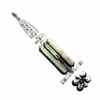 | Mars 1994 Russian manned Mars expedition. Study 1994. Soviet / Russian design for a Mars expedition powered by RD-0410 bi-modal nuclear thermal engines. A crew of five would complete the trip to Mars and back in 460 days. |
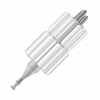 | Mars Expedition NASA Lewis 1960 American manned Mars expedition. Study 1960. The first NASA study of a manned Mars expedition outlined an opposition-class, nuclear thermal rocket powered spacecraft that would take seven astronauts to the planet's surface for 40 days. |
 | MK-700 Russian manned Mars flyby. Study 1972. Chelomei was the only Chief Designer to complete an Aelita draft project and present it to the Soviet government. |
| N1 Nuclear A stage Nuclear/LH2 propellant rocket stage. N1 nuclear upper stage study, 1963. Figures calculated based on given total stage thrust, specific impulse, engine mass. |
| N1 Nuclear AF stage Nuclear/LH2 propellant rocket stage. N1 nuclear upper stage study, 1963. Figures calculated based on given total stage thrust, specific impulse, engine mass. |
| N1 Nuclear V stage Nuclear/LH2 propellant rocket stage. N1 nuclear upper stage study, 1963. Figures calculated based on given total stage thrust, specific impulse, engine mass. |
| N1 Nuclear V-Bioshield Nuclear/LH2 propellant rocket stage. N1 nuclear upper stage study, 1963. Figures calculated based on given total stage thrust, specific impulse, engine mass. |
| Nerva Nuclear Engine for Rocket Vehicle Application. NASA/AEC Project of the 1960's to develop Nuclear Thermal Propulsion. NERVA stages, launched by the Saturn V, would have been clustered in earth orbit to send manned expeditions to Mars. Developed up to flight article test before cancellation. |
| Nerva 12 GW Notional nuclear/LH2 rocket engine. Study 1959. Used on Hyperion launch vehicle. |
| NERVA 1mlbf Notional nuclear/LH2 rocket engine. DAC Helios, DAC Helios ISI studies 1963. |
| Nerva 2/NTR American space tug. Study 2005. Upper stage / space tug - study completed 1991. Late 1980's update of 1960's Nerva design. |
| Nerva 2/NTR stage Nuclear/LH2 propellant rocket stage. Design as revised in detail in 2005. |
| Nerva Alpha Nuclear/LH2 propellant rocket stage. Nuclear stage designed to fit into the space shuttle payload bay. Additional propellant modules could be added in orbit. Such propellant modules would have a mass of 23,181 kg, including 21,265 kg of usable propellant. Given go-ahead in 1972, it would have been flight tested by 1982. |
| Nerva Alpha engine DoE nuclear/LH2 rocket engine. Study 1972. The final Nerva Alpha flight engine reference configuration as documented at the end of its development. |
| Nerva Gamma Nuclear/LH2 propellant rocket stage. Improved version of the Alpha nuclear stage designed to fit into the space shuttle payload bay. Additional propellant modules could be added in orbit. Such propellant modules would have a mass of 23,181 kg, including 21,265 kg of usable propellant. Given an Alpha engine development program, it would have been flight tested by 1984. In addition to propulsion, it would provide 10 to 25 MWe power for missions of two to five years duration. |
| Nerva Gamma engine DoE nuclear/LH2 rocket engine. Study 1972. The final Nerva Gamma flight engine was an improved version of the Alpha, a small engine that could be launched together with its stage and a payload in a single space shuttle launch. |
| Nerva NTR DoE nuclear/LH2 rocket engine. Study 1991. Late 1980's update of 1960's Nerva design. |
 | Nerva-1 DoE nuclear/LH2 rocket engine. Early version of Nerva engine proposed for use in Saturn and RIFT configurations in 1961. |
| Nova C-3 Nuclear/LH2 propellant rocket stage. . |
| Nova D-3 Nuclear/LH2 propellant rocket stage. . |
 | NPS-2 Rocketdyne nuclear/LH2 rocket engine. Nuclear Deep Space. Nuclear. Liquid hydrogen turbopumps, feed systems, and nozzles developed for KIWI-A, KIWI-B, Nerva, Phoebus IA, MFS-1, MFS-2, MFS-3, and Rover nuclear development systems. |
| Nuclear 12 Gw Notional nuclear/LH2 rocket engine. Helios A, Helios C study 1960. Nuclear second stage. |
| Nuclear 14 Gw Notional nuclear/LH2 rocket engine. Study 1960. Nuclear second stage Used on Helios B launch vehicle. |
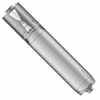 | PPM American space tug. Study 1968. The Primary Propulsion Module was the definitive 1960's design for a nuclear thermal rocket stage suitable for interplanetary operations. |
 | RD-0410 Kosberg nuclear/LH2 rocket engine. Experimental nuclear engine, propellant LH2. Developed 1965-94. Tested at Semipalatinsk test range in 1980s and was "the only operational nuclear engine in the USSR". First flight 1985. |
| RD-0411 Kosberg nuclear/LH2 rocket engine. Full-size nuclear thermal engine. Design concept 1965-94. Planned full-size nuclear thermal engine for Mars expeditions. Never progressed beyond study stage. |
| RD-410 Glushko nuclear/LH2 rocket engine. UR-700M concept. Developed 1960s. |
| RD-600 Glushko nuclear/LH2 rocket engine. Gas core nuclear engine worked developed 1962-1970 for use in second stage of two-stage interplanetary rockets. |
 | RN-6 Rocketdyne nuclear/LH2 rocket engine. Nuclear Deep Space. Nuclear. |
| RO-31 Kosberg nuclear/LH2 rocket engine. UR-700 Third Stage. Study 1967. Engine proposed for UR-700 third stage to achieve 250 metric ton payload to low earth orbit. Probably closely related to RD-0411. |
| Saturn S-N C-3BN Nuclear/LH2 propellant rocket stage. Nuclear upper stage considered in lieu of S-IVB in final Saturn C-3B study in November 1961. |
| Saturn S-N C-5N Nuclear/LH2 propellant rocket stage. Nuclear upper stage considered in lieu of S-IVB in final Saturn C-5 study in November 1961. |
| Saturn S-N V-25(S)U Nuclear/LH2 propellant rocket stage. Version of Nerva studied by Boeing for manned Mars expedition. |
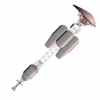 | STCAEM NTR American manned Mars expedition. Study 1991. |
| Timberwind 250 DoE nuclear/LH2 rocket stage. Development ended 1992. Used on Timberwind launch vehicle. |
| Timberwind 45 DoE nuclear/LH2 rocket stage. Development ended 1992. Used on Timberwind Centaur launch vehicle. |
| Timberwind 75 DoE nuclear/LH2 rocket stage. Development ended 1992. Used on Timberwind Titan launch vehicle. |
 | UMPIRE Douglas American manned Mars expedition. Study 1964. Unfavorable Manned Planetary - Interplanetary Roundtrip Expedition profiles were studied under NASA Huntsville contracts to General Dynamics and Douglas in June 1963. |
 | Von Braun Mars Expedition - 1969 American manned Mars expedition. Study 1969. Von Braun's final vision for a manned expedition to Mars was a robust plan that eliminated much of the risk of other scenarios. Two ships would fly in convoy from earth orbit to Mars and back. |
| YaERD-2200 Korolev nuclear/LH2 rocket engine. Developed 1962-69. |
| YaRD Type A Korolev nuclear/LH2 rocket engine. Study 1963. Design considered in N1 nuclear upper stage studies. Outgrowth of work done by Bondaryuk and Glushko on YaRD engines for nuclear ICBM's, but using liquid hydrogen as propellant. |
| YaRD Type AF Korolev nuclear/LH2 rocket engine. Study 1963. Design considered in N1 nuclear upper stage studies. Outgrowth of work done by Bondaryuk and Glushko on YaRD engines for nuclear ICBM's, but using liquid hydrogen as propellant. |
| YaRD Type V Korolev nuclear/LH2 rocket engine. Study 1963. Design considered in N1 nuclear upper stage studies. Outgrowth of work done by Bondaryuk and Glushko on YaRD engines for nuclear ICBM's, but using liquid hydrogen as propellant. |
| YaRD Type V-B Korolev nuclear/LH2 rocket engine. Study 1963. Design considered in N1 nuclear upper stage studies. This version had 7,000 kg bioshield for manned missions. Used liquid hydrogen as propellant. |
Engines:
Nerva 2 engine,
YaRD Type AF,
YaRD Type V-B,
RO-31,
Nerva-1,
Nerva Alpha engine,
Nerva Gamma engine,
Nerva NTR,
Nerva 12 GW,
NERVA 1mlbf,
NERVA/Lox Mixed Cycle,
NPS-2,
Nuclear 12 Gw,
Nuclear 14 Gw,
RD-0410,
RD-0411,
RD-410,
RD-600,
RN-6,
YaERD-2200,
YaRD Type A,
YaRD Type V.
Spacecraft:
Mars Expedition NASA Lewis 1960,
EMPIRE Aeronutronic,
EMPIRE Lockheed,
EMPIRE General Dynamics,
UMPIRE Douglas,
FLEM,
IMIS 1968,
PPM,
Von Braun Mars Expedition - 1969,
MK-700,
Nerva 2/NTR,
STCAEM NTR,
Mars 1994.
Stages:
Timberwind 45,
Timberwind 75,
Timberwind 250,
Nerva,
Hyperion Sustainer,
Helios A-2,
Helios B-2,
Helios C-2,
Nova C-3,
Nova D-3,
Saturn S-N C-3BN,
Saturn S-N C-5N,
DAC Helios ISI-2,
DAC Helios-2,
N1 Nuclear A stage,
N1 Nuclear AF stage,
N1 Nuclear V stage,
N1 Nuclear V-Bioshield,
Saturn S-N V-25(S)U,
Nerva Alpha,
Nerva Gamma,
Nerva 2/NTR stage.
Back to top of page
Home - Search - Browse - Alphabetic Index: 0- 1- 2- 3- 4- 5- 6- 7- 8- 9
A- B- C- D- E- F- G- H- I- J- K- L- M- N- O- P- Q- R- S- T- U- V- W- X- Y- Z
© 1997-2019 Mark Wade - Contact
© / Conditions for Use

